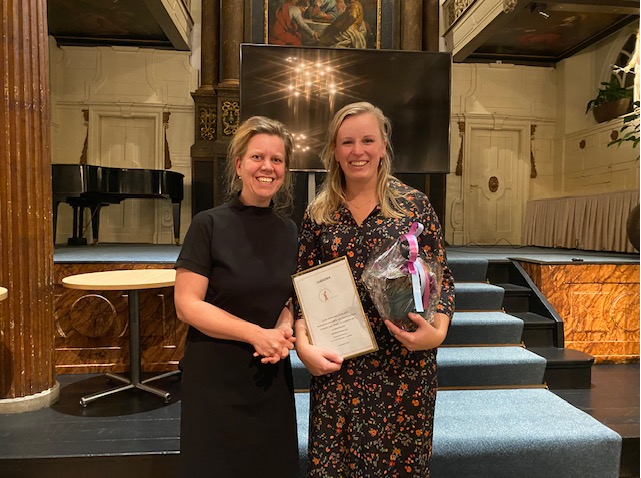Bertine Huisman, Research Physician at CHDR, has won the annual Young Investigator Prize of the Dutch Society for Vulva Pathology (NVvVP)! As a winner of this prize, Bertine presented our work on image guided surgery of vulvar cancer at the NVvVP fall symposium.
More specifically, our work concerned the pre-clinical phase of Image Guided Surgery (IGS) of vulvar cancer; the selection and evaluation of a cell surface biomarker highly expressed on (pre)malignant tissue and mildly expressed on healthy surrounding tissue. A probe, consisting of i.e. an antibody targeted against this biomarker and conjugated to a fluorescent label, can be used to illuminate the tumor and real-life guide the operator during surgical removal of the (pre)malignant tissue. We found that integrin αvβ6 could serve as a valuable target for vulvar cancer, especially for non-HPV-related vulvar cancer cases. Future studies should evaluate if integrin αvβ6 targeted probes used for IGS could help reduce morbidity and high recurrence rates related to surgical removal of vulvar cancer.
Bertine conducted this research under the close guidance of Dr. Mariette van Poelgeest and Kees Sier.

Abstract:
Integrin αvβ6 as a target for tumor-specific imaging of vulvar squamous cell carcinoma and adjacent premalignant lesions
Surgical removal of vulvar squamous cell carcinoma (VSCC) is associated with significant morbidity and high recurrence rates. This is at least partially related to the limited visual ability to distinguish (pre)malignant from normal vulvar tissue. Illumination of neoplastic tissue based on fluorescent tracers, known as fluorescence-guided surgery (FGS), could help resect involved tissue and decrease ancillary mutilation. To evaluate potential targets for FGS in VSCC, immunohistochemistry was performed on paraffin-embedded premalignant (high grade squamous intraepithelial lesion and differentiated vulvar intraepithelial neoplasia) and VSCC (human papillomavirus (HPV) -dependent and -independent) tissue sections with healthy vulvar skin as controls. Sections were stained for integrin αvβ6, CAIX, CD44v6, EGFR, EpCAM, FRα, MRP1, MUC1 and uPAR. The expression of each marker was quantified using digital image analysis. H-scores were calculated and percentages positive cells, expression pattern, and biomarker localization were assessed. In addition, tumor-to-background ratios were established, which were highest for (pre)malignant vulvar tissues stained for integrin αvβ6. In conclusion, integrin αvβ6 allowed for most robust discrimination of VSCCs and adjacent premalignant lesions compared to surrounding healthy tissue in immunohistochemically stained tissue sections. The use of an αvβ6 targeted near-infrared fluorescent probe for FGS of vulvar (pre)malignancies should be evaluated in future studies.

